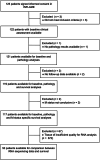Clinicopathological and molecular characterization of inflammatory breast cancer, the prospective INFLAME registry study
- PMID: 40442132
- PMCID: PMC12122667
- DOI: 10.1038/s41523-025-00764-5
Clinicopathological and molecular characterization of inflammatory breast cancer, the prospective INFLAME registry study
Abstract
Inflammatory breast cancer (IBC) is rare, with challenging diagnostics and unfavorable outcomes. Therefore, more molecular insight into IBC is needed. The comprehensive Dutch prospective INFLAME registry related IBC follow-up and treatment to histopathology and molecular analysis. Of consecutive patients, nationwide identified with newly diagnosed IBC, clinicopathological, treatment and outcome data were collected. Histopathology and RNA-sequencing were related to outcome. 125 IBC patients were enrolled. Forty-one (34%) patients had HER2 + , and 31 (25%) had triple-negative IBC. The estimated 3-year OS was 78% in M0 IBC and 29% in M1. PFS was worst in triple-negative IBC (median 7.9 vs 16.3 and 15.8 months in M1 HER2+ and HR + /HER2- IBC). DFS and OS in M0 IBC were better with guideline-concordant trimodal therapy than without (HR 0.15 and 0.15; p = 0.000005 and 0.00038). The unique prospective INFLAME confirms unfavorable IBC characteristics and outcomes. International efforts may support guideline adherence and identify IBC-specific targets.
© 2025. The Author(s).
Conflict of interest statement
Competing interests: The authors declare no competing interests.
Figures



References
-
- Robertson, F. M. et al. Inflammatory breast cancer: the disease, the biology, the treatment. CA Cancer J. Clin.60, 351–375, 10.3322/caac.20082 (2010). - PubMed
Grants and funding
LinkOut - more resources
Full Text Sources
Research Materials
Miscellaneous

